
Key Takeaways:
- Initial markup is a crucial pricing strategy in retail, calculated as a percentage to determine the profit added to the cost price of a product.
- Initial markup ensures a fair selling price that covers costs and includes a profit margin.
- Various factors influence initial markup percentages, including industry, market demand, and economic conditions.
- Luxury goods may have a 60% initial markup, grocery items may have 15%, and wine shops fall in between at 40%, showcasing the diversity across retail verticals.
One key factor that plays a pivotal role in determining profitability is the concept of initial markup. Initial markup, or IMU, is a fundamental pricing strategy employed by retailers to establish the selling price of a product. This number ensures that it covers costs and contributes to overall profitability.
In this exploration, we delve into the intricacies of initial markup, its calculation, significance, and its role in retail operations.

Definition and Calculation
Initial markup helps retailers determine how much extra money they want to make on a product compared to what they paid. It refers to businesses’ immediate pricing strategy after acquiring goods from suppliers and putting them on shelves for retail purchases.
It’s calculated as a percentage and uses this simple formula:
To compute the initial markup formula for the selling price:
These formulas are useful because they allow retailers to set a fair selling price that covers their costs and includes a profit margin. They ensure that the price customers pay for a product considers all costs to the store and what the store hopes to earn from sales.
Initial Markup vs. Gross Margin
Initial markup and gross margin are two of the most important financial metrics in retail. However, they are distinctly different.
IMU represents the percentage difference between the cost price of a product and its initial selling price, serving as the foundation for pricing strategies.
In contrast, gross Margin is the percentage difference between the selling price and the cost of goods sold, reflecting the profitability of each sale after accounting for the direct costs associated with the product.
While Initial markup focuses on the initial pricing decision, gross margin provides a broader perspective by considering the overall sales profitability, factoring in additional costs like discounts and returns.
Significance in Retail Operations
Initial markup is a critical factor that influences the financial health of a retail business in several ways. Here are three important aspects of determining initial markups:
Covering Costs
Covering the costs of acquiring and merchandising products is a must. This includes the purchase price and transportation, storage, handling expenses, and more.
By incorporating these costs into the initial markup, retailers ensure that the selling price reflects the true economic value of the product.
Profitability
Initial markup plays a vital role in the overall profitability of a business. A judiciously set initial markup percentage allows retailers to balance attracting customers with competitive prices and maximizing profits.
This is particularly important in an environment where consumer behavior is influenced by price sensitivity. Retailers must navigate the delicate balance between offering value and sustaining profitability.
Making Adjustments
Initial markup is also a dynamic metric that can be adjusted based on market conditions, demand fluctuations, and competitive landscape. It allows retailers to respond to changes in the business environment, ensuring that pricing strategies remain agile and aligned with market dynamics.
Making full use of sales analytics, consumer behavior, and responses to price changes will ensure that retailers are nimble and strategic with their initial markup tactics.
Factors Influencing Initial Markup
The retail world comprises vastly diverse environments, verticals, and strategies. As such, several factors come into play when determining a product’s initial markup.
Types of Products
One key consideration is the product category and its perceived value in the market. High-end or niche products often command a higher initial markup than everyday essentials.
These products are associated with higher perceived value, allowing retailers to set a more substantial initial markup than everyday essentials. For example, grocery products typically have lower initial markups than designer handbags because they typically face stiff competition and higher consumer price sensitivity concerns.
Market Demand
Demand for a particular product significantly influences the initial markup strategy. When a product is in high demand, retailers often find themselves in a favorable position to set a higher initial markup percentage.
This is driven by consumers’ eagerness to acquire popular items, allowing retailers to capitalize on this demand by pricing the product at a premium. The relationship between market demand and initial markup is a strategic way for retailers to align pricing with consumer enthusiasm, thereby maximizing revenue potential.
Economic Factors
Furthermore, fluctuations in economic conditions, especially instances of inflation, can exert pressure on supplier costs. This influences the overall cost structure for retailers. For most of the world, inflation has been both highly impactful and somewhat unpredictable from 2020-2023.
In such scenarios, retailers must stay vigilant, regularly reassessing their initial markup percentages to adapt to changing cost dynamics. This vigilance will help ensure that pricing strategies remain resilient, safeguarding healthy profit margins.
Determining Optimal Initial Markup Percentages
A good initial markup percentage should be sufficient to cover the cost of goods sold and operational expenses and generate a reasonable profit. Industry standards often range from 15% up to 60%.
Retailers must consider factors such as competition, market demand, and customer sensitivity to pricing when setting their initial markup. Striking a balance between competitiveness and profitability is essential, and the optimal initial markup may vary for different businesses, verticals, and market conditions.
Initial Markup By Vertical
Percentages vary widely across different retail verticals. Here are three examples of average initial markup percentages from different retail verticals:
Luxury Clothing and Apparel:
- Average Initial Markup Percentage: 60% (source)
- Example: A luxury fashion retailer purchases a trendy jacket for $100 and sets an initial markup of 60%. Starting with the cost price of $100, add 60%, making the final selling price $160.
- Markup Explanation: This initial markup helps cover the cost of manufacturing and shipping and provides a margin for profit. At the frequency and rate at which trendy jackets are sold (as opposed to beer or eggs, for example), a 60% margin is appropriate. Plus, higher-end brands invest more heavily in decor, retail real estate, and employee compensation.
Grocery Store:
- Average Initial Markup Percentage: 15% (source)
- Example: A grocery store purchases a case of organic olive oil for $20 a bottle and sets an initial markup of 15%, making the final retail price $23.
- Markup Explanation: Grocery retail often operates on lower initial markup percentages due to higher volume sales and a ton of competition. Still, individual grocery products may vary with markup percentages. For example, grocers who know they hold an exclusive product may increase initial markups for those items.
Wine Shop:
- Initial Markup Percentage: 40% (source)
- Example: A local wine retailer acquires 10 cases of wine at $10 per bottle. They then set and set an initial markup of 40%. Thus, the selling price would be $14 per bottle.
- Markup Explanation: When it comes to frequency of sales, exclusivity, and competition, wine shops fall in the middle of the pack. While there are many places to buy wine, stores often offer niche, curated selections for their customers. Offering expertise and selection allows wine shops to have relatively high initial markup percentages. Liquor stores, on the other hand, have much lower margins due to higher competition and less exclusivity.
These examples highlight the diversity of initial markup percentages across different retail verticals. The chosen markup percentages are illustrative and may vary based on specific market conditions, business strategies, and external factors influencing each industry.
Challenges and Considerations
While initial markup is a powerful tool in the retail arsenal, it comes with challenges. Setting an initial markup that is too high may lead to decreased sales volume, as customers may be deterred by perceived high prices.
On the other hand, setting it too low may compromise profitability and hinder the ability to cover costs effectively.
Retailers must know that initial markup is just one piece of the pricing puzzle. Markdowns, discounts, and promotions are common in the retail landscape, and these need to be factored into the overall pricing strategy to ensure a balanced and sustainable approach.
Conclusion: Measuring the Ideal Initial Markup
Measuring the ideal initial markup with retail point-of-sale analytics is essential for optimizing profitability in the competitive retail landscape. By leveraging real-time sales data, businesses can assess the performance of individual products and categories, allowing for informed pricing decisions.
Modern POS provides sales analytics and data insights by capturing transactional data in real-time, offering a comprehensive view of product performance, customer behavior, and inventory levels.
Analyzing initial markups helps identify trends and consumer preferences, enabling retailers to adjust pricing strategies to maximize revenue. This data-driven approach enhances overall financial performance and ensures that products are priced strategically to meet market demand and maintain a healthy profit margin.
KORONA POS offers advanced, dynamic sales analytics for businesses in all verticals. Get a comprehensive look at all of your retail KPIs. Click the link below to schedule a demo today!












